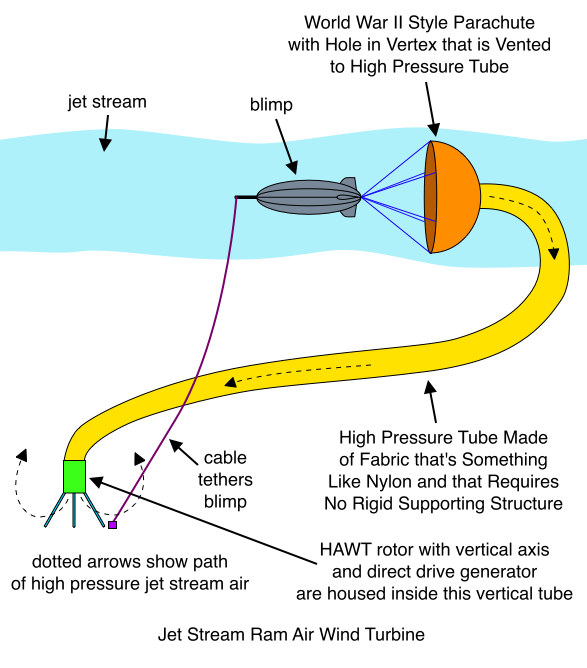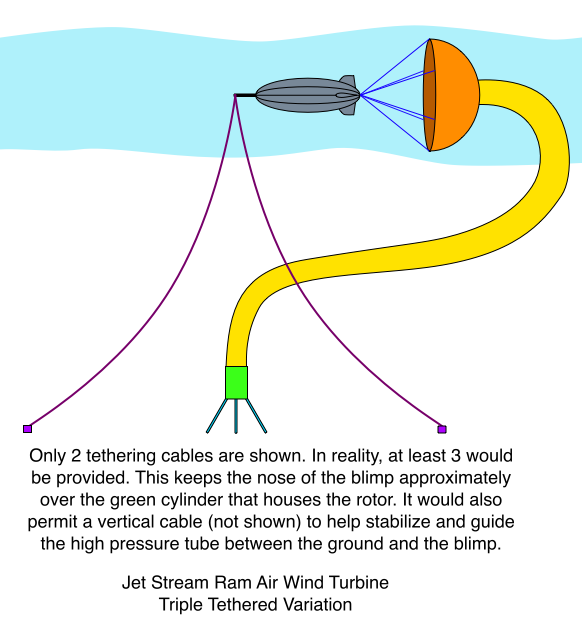In earlier posts I have mentioned that a turbine capable of harvesting the energy of jet streams would probably be better for newspaper headlines than for an economical approach to wind electricity, since it would probably be cheaper and more effective to build several smaller low altitude turbines than a single monster that could tap into the jet streams. But it got me to realize that there are no jet stream turbines on the Salient White Elephant. This is Salient, to be sure, but is it White Elephant? Certainly not! And already I can hear not a little hubbub from the Canadian Parliament behind me patting their tables and gushing heah heah! So let’s just round things out with a couple of jet stream turbines before tensions run too high and one of the hairs on the head of the Right Honourable Stephen Harper springs noticeably out of place, shall we?

For some reason, I’m usually biased toward using suction rather than high pressure in my flow accelerator ideas. But one advantage of using ram air pressure in the machine proposed here is that it would keep the long fabric tube inflated. This is very significant of course, since one of the biggest challenges in designing an airborne turbine is keeping weight to a minimum. Using high pressure might eliminate any rib-like supporting structure that would otherwise be required for the tube. I guess you’d have to stabilize the fabric tube by attaching it to the tethering cables at various intervals, but who knows… maybe somebody can design a way around this requirement.
Triple Tethered Variation

Multiple Blimps Variation
There are many variations of the ideas proposed here, but let me discuss one in particular. This idea emphasizes a technique I’d like to use to bring these pie-in-the-sky airborne turbines a little closer to feasible. Imagine eight blimps. Each is tethered by at least three cables to keep the blimps from moving around too much. An aerial view would reveal that the blimps are situated at the vertices of a gigantic octagon. It is important to note that the “diameter” of the octagon is far from insignificant. I can’t give you a number… maybe two or three football fields? Each blimp has a parachute and a high pressure tube, just as described above. All of the high pressure tubes converge at the center of the octagon, where they connect to a single larger high pressure tube that takes the jet stream wind down to the ground.
What’s so great about this variation? Well… let me first list what I believe may be the salient objectives of airborne turbine design:
- If possible, no moving parts in the air.
- If possible, no fiberglass, electrical cable, gearboxes, drive shafts, or electrical generators in the air. (Ever notice how the components of a wind turbine that have to do with mechanical and electrical power are about the most dense (heaviest) things known to engineering kind?!)
- MINIMIZE WEIGHT, MINIMIZE WEIGHT, MINIMIZE WEIGHT!!!!!!!!!!!
So the idea here is that instead of having eight different tubes, we attempt to minimize weight by having a single large tube carry wind from the jet stream to the ground. This is desirable because the really long distance is from the jet stream to the ground. Once at the center of the jet stream octagon, it isn’t much further to the blimps. So could we use this trick to reduce the overall weight of the machine?
Well, whether this trick will work or not… I think you see my point. What is needed is a kind of linear programming style optimization that minimizes weight of fabric per kilowatt of capacity.
Can We Really Reach the Jet Stream?
No. The jet streams are like 30 to 40 thousand feet off the ground. (The cruising altitude of jet airplanes!) So we can’t reach the jet stream with the design proposed in this post. But we can certainly reach a higher altitude than today’s state of the art wind turbines! If you want to see a more practical configuration that uses the principles described in this post, check out the Practical Artificial Pressure Differential Wind Turbine.

